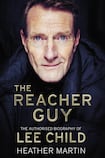
The subjects of literary biographies, by and large, are both widely revered and safely dead. There’s no great mystery in this. Chunky biographies are a seasonal phenomenon, among the dependable unit-shifters that can hold their own in the pre-Christmas big leagues. And the consensus seems to be that – unlike, say, footballers or former commandos – most living writers just aren’t box office material.
There are exceptions, of course, and at first glance it might seem inevitable that Lee Child should make the cut. He’s long been a celebrity writer, a very different breed from celebrities who’ve written books. But as Heather Martin’s title suggests, that’s not what makes him truly interesting. Lee Child created Jack Reacher, a character of such gigantic appeal that even this A-list author remains in his shadow. And to invent Reacher, Lee Child first had to invent himself.
James Dover Grant, or Jim to all who remember him, was born in Coventry in 1954. But it is to Birmingham that he holds allegiance, having moved there with his stolidly middle-class parents at the age of four. As Martin shows, this tribal loyalty is deeply felt. He remains a passionate Villa fan, naming a roster of Reacher characters for select former players, and he identified deeply with the city’s artisanal traditions.
“They really knew how to make stuff back then,” he remarks. His example is a perfect custom-made bolt, turned out in half an hour by a local craftsman, but it was a virtue he would come to prize in other forms.
But his origins became the subject of mythmaking too, a theme that recurs in this warm-hearted but meticulous study. Lee Child’s IMDB entry, as Martin observes, strikes a more stylised note: ‘[He] was born . . . in the heart of the industrial badlands. Never saw a tree until he was 12.” Unsurprisingly, this is a bit of a stretch – the Grant family home was on Underwood Road, “a broad treelined street” – but the Lee Child brand wasn’t entirely a later invention. Like him, the young Jim Grant knew a thing or two about packaging and selling himself.
‘Unusual sensitivity’
Martin shares the recollections of a former teacher, who recalls Jim fondly (they shared a love of theatre), but who was wise to his capacity for shapeshifting. He was “a slippery, shadowy figure”, the teacher confides, but the image he projected was a product of “unusual sensitivity”. It was a sensitivity that made him susceptible to slights, not least by the parents he remembers as “cold and unloving”.
More than anything, though, Jim’s sensitivity made him clear-eyed about his surroundings. Electrified by the early Beatles singles, he watches them storm America and a fiery ambition took hold. “Four guys had escaped”, he later wrote, “in the biggest possible way”.
The first step was a job in television, where his now fully formed swagger proved an asset. “Look no further,” his application read, “I’m your man.” He was, as it turned out, and if his boozy and swashbuckling days at Granada yield relatively few salacious anecdotes, they are not without standout moments. In one such episode, we see the young Turk face down a senior manager who orders him to transmit the one o’clock news. It was a non-union production and his NUJ colleagues were in a dispute with the bosses. Jim refused. That he was quickly reinstated following his subsequent firing made his stand no less ballsy and principled. Reacher himself would surely have approved.
Public persona
But the choicest insights, at least for fans of the novels, are those that shed light on aspects of craft. This too is central to the much-burnished public persona, and for believers it is now an article of faith that he writes only one draft and disdains all forms of planning. It’s a legend the seasoned practitioner may well have grown into, but the young novice laboured towards perfection like anyone else. Over two riveting pages, we see him honing the opening lines of what would become Killing Floor. He junks the unpromising first attempt entirely, and it takes five or six iterations before he gets to the two indispensable sentences that now seem graven in stone: “I was arrested in Eno’s diner. At twelve o’clock.”
Martin is a clearly a fan – who isn’t? – but the scholar in her keeps those impulses in check. Her archival diligence – and an obvious rapport with her subject – allows her to gently puncture the Child mythos when needed. But scholars are close readers, too, and she is just as good at combing the text for telling quotes, for traces of Child in Reacher; for traces anywhere of the hulking but vulnerable boy that Jim once was.
She is a skilled and audacious interlocutor, too, but her subject is just as adept an interviewee. He is unfailingly suave and frequently beguiling, but forthright only in his pronouncements on others. Even his moments of candour can seem precision-engineered. Still, a few are starkly affecting. “I was looking for love,” he confides, by way of accounting for his chosen path. The superhuman Reacher may be loved by millions, but it’s the Reacher Guy who has the edge: he knows what is to be human.
Paraic O’Donnell is a novelist and critic. His most recent novel, The House on Vesper Sands, is published by Weidenfeld and Nicolson










